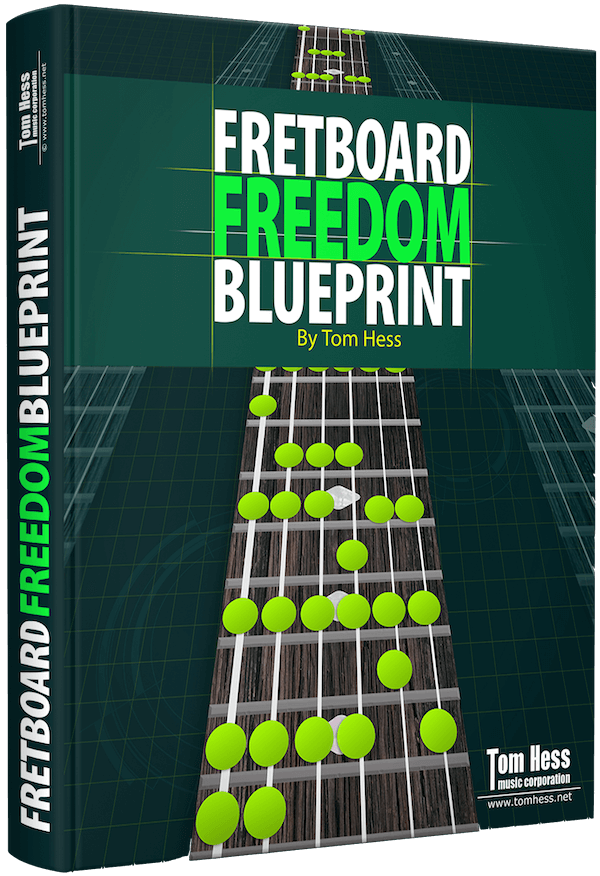Guitar Soloing: Breaking Out Of Lead Guitar Scale Boxes

EMAIL TO GET ACCESS
By submitting your info, you agree to send it to Tom Hess Music Corporation who will process and use it according to their privacy policy.
If you find yourself stuck in guitar scale boxes when you play lead guitar solos…
This guitar soloing article will help you solve this problem and play pro-sounding guitar licks all over the guitar neck.
(Even if you're not an advanced guitar player yet.)
Here is how:
First...
I'll show you a new simple way to play pentatonic scales that:
– requires almost no practice to memorize, and
– makes it impossible to stay stuck in the usual guitar scale boxes you usually play in.
(This makes your guitar licks more creative right away.)
Second…
I'll show you other guitar soloing and fretboard visualization tricks that help you memorize other scales faster.
(They also make your guitar solos much more expressive.)

EMAIL TO GET ACCESS
By submitting your info, you agree to send it to Tom Hess Music Corporation who will process and use it according to their privacy policy.
To begin...
Check out this lead guitar soloing video that shows you a simple and fun way to play pentatonic scales:
Now that you know the basics of breaking out of guitar scale boxes when you play guitar solos, let's go deeper.
Here are five more lead guitar scale practice and visualization tips that help you level up your guitar licks and solos:
Tip #1 For Breaking Out Of Guitar Scale Boxes: Memorize Scale Shapes All Over The Guitar
One of the best ways to avoid getting stuck in guitar scale boxes is to stop thinking of guitar scale ‘shapes’ (or boxes). Instead – learn to see the entire guitar fretboard as one giant scale pattern.
This gives you maximum freedom for playing all over the guitar as you create guitar licks and guitar solos.
How do you do this?
Learn how to play the scale starting from each note in the scale. Like this:
Say you're playing the A natural minor scale: A B C D E F G.
The most obvious pattern for this scale (which everyone learns first) is the one starting from the A note (5th fret of the 6th string)
But can you play the same scale starting (with your index finger) starting with the B note (7th fret of the 6th string)? How about starting with the C note (8th fret of the 6th string)? And of course: starting with the D note, the E note, the F note and the G note?
Most guitarists would struggle to play those shapes just as easily as they can play the first one.
This is what often causes the dreaded “stuck inside the guitar scale box” feeling.
To solve this, practice all 7 guitar scale patterns with equal amount of focus until you have them fully memorized.
Question: “But Tom Hess, won’t doing this take forever?”
Answer: No. You can very easily memorize all 7 shapes of any guitar scale with a month (or faster), especially if you follow the bonus tip I lay out below. But more importantly: once you memorize the 7 patterns of one scale, it becomes much easier to memorize lead guitar scale shapes for other scales you learn.
That’s because:
1. The patterns (of the same scale) don’t change when you change keys. So, you can simply move them up and down the fretboard to play in different keys.
2. The patterns of other scales all follow the same logic (despite having different notes). This means: after you memorize the lead guitar scale patterns of one scale, you’ll memorize the scale patterns of any new scale much faster. (This makes it much easier to create guitar licks and guitar solos using that scale.)
Bonus guitar scale box pattern memorization tip:
Memorize the scale patterns away from the guitar.
You can do this by putting your fretting hand on your picking hand’s forearm, visualize starting on a certain fret of your guitar and move the fingers up and down your forearm as if you are playing your guitar.
You can do this while commuting (e.g. while stopped at a red light in your car), while lying in bed falling asleep, while standing in line at the grocery store, etc.
This will help you squeeze in more practice time even if your schedule is very hectic.
Tip #2 For Breaking Out Of Guitar Scale Boxes: Practice Scales Horizontally
Most lead guitar players practice guitar scale boxes vertically (from the sixth string to the first string). But that is just one of many ways to play scales on guitar.
Another way (that can help you create cooler lead guitar licks and guitar solos) is to play guitar scales horizontally.
This means: playing guitar scale patterns from the lowest frets to the highest frets (and back).
This helps you see how guitar scale boxes connect on the fretboard (and see the entire guitar neck as one giant scale shape).
Watch this lead guitar lesson video where I show how to do this:
Play the scale horizontally using 3 notes per string on two strings at a time. For example: play notes C D E (frets 1, 3, and 5) on the B string and notes F G A (also frets 1, 3, 5) on the high E string. These are the first 6 notes of the C major scale. Then, move up 2 frets and play notes D E F (frets 3, 5, 6) on the B string and notes G A B (frets 3, 5, 7) on the high E string.
Keep going up one note at a time (horizontally) until you run out of frets.
Repeat this pattern on every pair of strings (G and B, D and G, A and D, and low E and A).
Question: "Tom Hess, what if I struggle to do the big stretch with two whole steps on frets 1 3 and 5?"
Answer: The problem likely lies in your hand position. If your hand (and fingers) are closed into a tight claw, this makes it impossible to spread the fingers and reach the notes.
Open the knuckles of your fingers when you play and your reach will increase instantly.
Watch this lead guitar video that shows how:
Tip #3 For Breaking Out Of Guitar Scale Boxes: Play Scales Diagonally
One of the fastest ways to cover the entire fretboard with your guitar scales is to play scales diagonally. Like this, for example:
On the 6th string, play frets 3, 5, and 7 (notes G A and B). On the 5th string, play frets 3, 5, and 7 (notes C D and E). These are the first 6 notes of the G major scale.
Now, shift your hand up 2 frets and play frets 5, 7, 9 on the D string (notes G A and B) and frets 5, 7, 9 on the G string (notes C D E).
Next, shift your hand up 2 more frets and play frets 8 10 and 12 on the B string (notes G A B) and frets 8, 10, and 12 on the high E string (notes C D E).
This is an example of playing the G major scale diagonally.
Question: "But Tom Hess, doesn't the major scale have 7 notes? How come you played 6-note patterns in the diagonal fingering?"
Answer: Yes, there are 7 notes in major (and minor) scales. But you don't need to always play all the notes (or all the notes in order). This is what allows you to come up with creative guitar licks in your guitar solos out of basic guitar scale boxes.
And the purpose of diagonal guitar scale shapes is to allow you to not be stuck in a single scale shape, while covering a large section of the fretboard quickly.
Watch this video to learn more about how to use diagonal scale shapes in your lead guitar playing.
And of course, you can (and should) combine playing scales diagonally with playing horizontally and vertically.
Tip #4 For Breaking Out Of Guitar Scale Boxes: Create Scale Sequences
As you build fluency with guitar scale boxes and memorize all the guitar scale shapes of a new scale…
The next step is to practice sequencing the notes (so you can sound more musical when you play guitar solos).
What are lead guitar scale sequences?
A sequence is where you create a short melodic pattern of 3-4 notes and move it up (and down) through the scale.
For example:
The first 4 notes of the C major scale (C D E F) starting on the first note (8th fret of the 6th string). Then, play 4 notes starting from the 2nd note of the scale (D E F G). Then, play 4 notes starting from the 3rd note of the scale (E F G A). Next, play 4 notes starting from the 4th note of the scale (F G A B).
You're now playing (one possible) scale sequence inside the first guitar scale box of the C major scale.
Here are more examples of how to use lead guitar scale sequences in your guitar licks and guitar solos:
Bonus tip: practice creating scale sequences horizontally (such as on one string), as well as vertically.
Horizontal (single-string) scale sequences also happen to be fantastic exercises for 2-hand synchronization.
Single-string playing forces your hands to be in sync for every single note (which helps you to play with better synchronization on vertical lead guitar scale sequences).
This is particularly true if you practice your guitar scale licks unplugged. Playing unplugged makes it easy to tell when you're articulating every note clearly (and when you're not), so you can clean up sloppy 2-hand synchronization more easily.

Tip #5 For Breaking Out Of Guitar Scale Boxes: Practice Creating Lead Guitar Licks
One of the best ways to break out of the rut of being stuck in guitar scale boxes is creating guitar licks that don't sound like scales.
Here is how:
1. Start by choosing the beginning and ending notes. This bookends your guitar lick and keeps you from starting to noodle.
2. Improvise a handful of notes (from the scale) in between your starting and ending notes to fill out your guitar lick. This completes your lick.
3. Repeat the lick a handful of times to refine its phrasing. This means: focus on how you play the notes (and how much emotion you can squeeze out of them).
Add vibrato to some of the notes, articulate some notes with slides and legato, add picking hand rakes, play over the bar, use rubato and/or vary the rhythm of the notes.
This last step can keep you busy for a while. And the better your phrasing becomes, the more expressive your guitar licks and guitar solos will sound (even if you don't play fast).
Here is an example of what practicing lead guitar phrasing looks and sounds like:
Bonus tip: Create guitar licks using guitar scale box shapes you're less familiar with. (For example: use shapes 2-7 of the major scale or shapes 2-5 of the minor pentatonic scale.) This helps you memorize them faster and enables you to master your fretboard fully. When you do, playing creative guitar solos becomes much easier.
Now that you know how to break out of guitar scale boxes, I want to show you a few more very powerful (but simple) ways to use scales in guitar solos and achieve true fretboard freedom on guitar. I show you how in my free eGuide: Fretboard Freedom Blueprint. Download it today and discover the guitar playing secrets most guitarists don't know.


Become the best guitar player you can be with breakthrough guitar lessons online.

